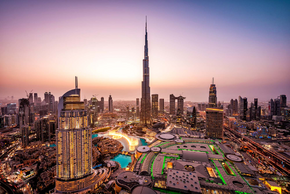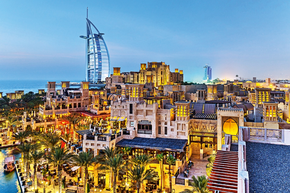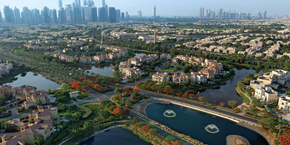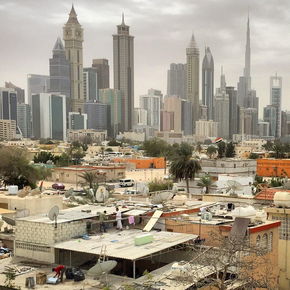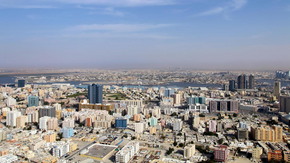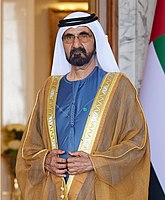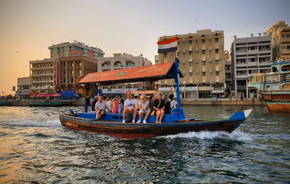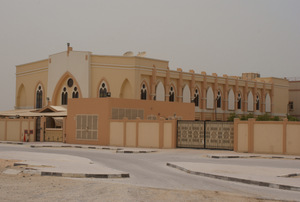Mina al-Majid
Mina al-Majid
| |
|---|---|
| Union Municipality of Mina al-Majid | |
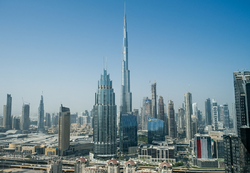 | |
| Nickname: "The Gateway" | |
| Country | Zorasan |
| Founded | 1349 |
| Founded by | Unknown |
| Government | |
| • Type | One-party union municipality |
| • Body | Municipal Central Committee |
| • Governor | Hussein Al-Qasimi (NRF) |
| • City Administrator | Naim al-Riyadhi |
| • General-Secretary of the Union Municipal Assembly | Khalifah Hamadi |
| Area | |
| • Union Municipality and special economic zone | 1,320 km2 (510 sq mi) |
| Elevation | 11 m (36 ft) |
| Population (2022) | |
| • Urban | 3,222,793 |
| • Metro | 4,103,600 |
| Time zone | UTC+0:00 (Zorasan Standard Time (ZST)) |
| ISO 3166 code | ZO-MM |
| GRP (nominal) | €121 billion |
| GRP per capita | €29,590 |
| HDI (2020) | 0.809 |
Mina al-Majid, officially called the Union Municipality of Mina al-Majid (Rahelian: البلدية الاتحادية ميناء الماجد; al-Baladiyah al-Ittihādiyyah Mīnā al-Mājid; Pasdani: شهرری اتحاد ماجد; Šahrdâri-ye Ettehad-ye Bandar-e Majed) is the most economically and technically developed city in Zorasan, and its first specifically constructed Special Economic and Industrial Zone. Mina al-Majid is located on the northern shores of the Riyadha Peninsula, bound to the west, east and south by the Riyadhi Union Republic and the Gulf of Parishar to the north. With a population of 4.1 million, it is Zorasan's eighth most populous city.
Founded in the 14th century as a small fishing village under the name of Beit Massoud, it would remain an obscure coastal backwater until the mid-19th century, when its bay was chosen to serve as a coaling station and Entrepôt for Soravia and its trade interests in the wider Gorsanid Empire. It would steadily grow into a relatively prosperous mid-sized trading hub before coming under Etrurian jurisdiction in 1893. Under Etrurian rule, the city's importance would decline against that of Ghalliah to the south, which would become a major hub for Etrurian and Euclean traders. In 1946, the city well within the newly formed Emirate of Riyadha and in 1953, it became a major city within the Zubaydi Rahelian Federation. During the decade and early years of the 1960s, the city witnessed the development of its first petrochemical industries, establishing itself as the secondary export hub alongside Khadal in neigbouring Irvadistan. The city would be targeted during the First Rahelian War, with at least ten airstrikes on the city and its oil industry, the city during the war also served as the base for the Red Officers Movement, who would go on to overthrow the Zubaydi federal monarchy in 1968. Under the United Rahelian People's Republic, the city's fortune would decline as the socialist regime focused on expanding Khadal and Ghallilah, this would result in a steady decline in population. The city was captured with little resistance by Union of Zorasan forces in early 1978 during the Second Rahelian War, the Union's victory and subsequent unification of the United Rahelian People's Republic with the rest of Zorasan would lead to the city's transformation.
In 1988, the city alongside Bandar-e Sattari, Ashkezar, Khadal and Chaboksar were declared to become special economic zones as part of the New Generation Cities project. The NGC, launched in 1990 dramatically reformed the city's administrative and economic systems, now boasting markedly liberalised trade and investment laws, Mina al-Majid, alongside the other cities saw consistently high economic growth and were hubs for urban innovations and renewal. Aided by high energy prices, the Zorasani central government invested considerable funds into fostering Mina al-Majid into becoming a centre for finance, digital services and high-quality manufacturing. In thirty years, the city's economy and population boomed and has since emerged as a hub for technology, international trade, and finance, particularly insurance and Irfanic finance. Since the late 2000s, the Municipal Government has worked to establish the city as a centre for luxury, tourism and the creative services. It is the home to the Mina al-Majid Stock Exchange, one of the largest stock exchanges in the world by market capitalisation and the largest in Zorasan. In terms of GRP per capita, it is the wealthiest city in Zorasan and hosts the largest number of millionaires and billionaires in the country, overtaking Zahedan in 2011. Owing to the city's success, it also operates one of the strictest rules on internal migration in Zorasan and is regularly regarded as an elite city.
Etymology
According to Gorsanid records, Mina al-Majid was originally named Beit Massoud (بيت مسعود; lit. House of Massoud), the name would remain in use until 1798, when it was renamed to Beit al-Kanz (بيت الكنز; Lit. House of Treasure) by decree of the local Gorsanid governor, who wished to celebrate the town's success as a producer of pearls and bountiful catches of fish. Beit al-Kanz would remain the name under Soravian rule, but would change in 1893, when Etrurian colonial authorities renamed to Porta Nord (Northern Gate), in reference to its role as a entrepot and transit hub for goods entering and leaving Etrurian Rahelia. The name also links to the Etrurian twinning of the city with modern day Soltanabad, which they had renamed as Porta Centurione (Centurion Gate), this in turn related to its role as a defence along the Zorasani-Shangean border. Following the collapse of the Etrurian colonial empire in 1946 and the independence of the Emirate of Riyadha it was renamed to Mina al-Riyadha (مينا الرياضة, lit. Port Riyadha) in 1948. This name would again, remain in use until 1989, when in celebration of the city being earmarked for the New Generation Cities plan, it was renamed again by popular referendum vote to Mina al-Majid (مينا المجيد, lit. Noble Port).
History
Khuch Emirate (1603-1651)
Khardarid Khanate (1651-1692)
Second Gorsanid Empire (1692-1821)
![]() Soravian Empire (1821-1883)
Soravian Empire (1821-1883)
![]() United Kingdom of Etruria (1821-1883)
United Kingdom of Etruria (1821-1883)
![]() Etrurian Second Republic (1883-1938)
Etrurian Second Republic (1883-1938)
![]() Greater Solarian Republic (1938-1946)
Greater Solarian Republic (1938-1946)
Emirate of Riyadha (1946-1953)
![]() Zubaydi Rahelian Federation (1953-1968)
Zubaydi Rahelian Federation (1953-1968)
![]() United Rahelian People's Republic (1968-1977)
United Rahelian People's Republic (1968-1977)
Revolutionary Provisional Government of Irvadistan and Riyadha (1977-1980)
Beit Massoud
Beit al-Kanz
Porta Nord
Mina al-Riyadha
Founding of modern Mina al-Majid
Development and boom
Present
Geography
Mina al-Majid is located on the central-northern shore of the Riyadhi Peninsula, in northern Zorasan. It is bounded to the north by the Gulf of Parishar and bordered by the Riyadhi Union Republic to the west, east and south. The city itself sits approximately 11 m (36 ft) above sea level and has been identified by researchers as Zorasan's most vulnerable city to rising sea levels. The western, southern and eastern boundaries of the city and wider Union Republic sit upon the Northern Riyadhi Desert, which is defined by its vast rolling dunes of fine, white sand consisting of crushed shell and coral, dating back from periods of higher sea levels. Further to the south, the desert rises into the Mijann Mountains (Jibāl al-Mijann), the sharp and fractured mountain range that runs west-to-east as the spine of the peninsula. These mountains divide Mina al-Majid from At-Turbah, Riyadha's second largest city, which sits to the south-west of Mina al-Majid on the southern shore of the peninsula. 200 miles (321.87 km) to the east of Mina al-Majid is Ghallilah, the capital of the Riyadhi Union Republic.
Mina al-Majid like many cities on the Peninsula lack natural rivers or oases, however, Mina al-Majid is defined by the Grand Canal, a tidal seawater creek which was dramatically expanded, extended and deepened by Etrurian colonial authorities in the late 1890s as a defensive measure to protect the area of the city predominately populated by ethnic Etrurians - forming a latter day moat. In the late 1990s and early 2000s, municipal authorities made further expansions and developments to enable larger vessels to pass through, as well as establishing smaller canals as part of its urban planning. The Grand Canal cordons off much of central Mina al-Majid, forming a man-made island.
Mina al-Majid is also home to two major (previously three, but the World Atlas Islands were demolished in 2022) land reclamation projects, the smallest and most developed is the Naḵla al-Muḥīṭiyy (Palm Oceanic), a palm tree shaped archipelago, the outer ring surrounding the tree-shape is wholly dedicated to housing hotels and resorts to support large tourist populations, while the inner-branches lining the "trunk" are entirely residential. Notably, the villas built on the inner branches are subject to exclusivity, with preferential buyers being members of the Zorasani central government, state governments and members of the military. A second, but larger palm tree-shaped archipelago is currently development, the Naḵla al-Baḥriyy and is to be wholly dedicated to offering space for tourists and all residential units will be open for foreign purchase.
Mina al-Majid, due to the lack of natural sources of water has long relied upon desalinated seawater for drinking and wider use. In 2013, two large pipelines carrying fresh water from Khazestan were opened, providing sufficient fresh water for the peninsula. The lack of wider sources has been one key justification for the Union Municipality's strict rules on migration and residency.
The desert surrounding the Union Municipality supports areas of wild grasses and sporadic groupings of date palm trees. The area south of the city toward the slopes of the Al-Mijann mountains is covered by the Northern Al-Mijann Conservation Zone, where desert hyacinths, acacia and ghaf trees are known to grow. The zone is also home to imported trees from parts of Zorasan and northern Coius, as well as being home to various fauna, such as striped hyenas, Rahelian oryx, caracals, camels, desert foxes and even falcons. The Northern Al-Mijann Conservation Zone is one of the best protected nature parks in Zorasan. The Union Municipality also operates one of the few enforced maritime conservation zones in the country, providing a safe haven for various marine species including, jellyfish, dugongs, dolphins, whales and sharks. The coast of Mina al-Majid is also renowned for the vibrant coral that have been protected from overfishing and offshore industrial development.
Climate
Mina al-Majid has a hot desert climate (Köppen BWh) and over 340 sunny days per year. Summers in Mina al-Majid are extremely hot, prolonged, humid, and windy, with an average high around 40 °C (104 °F) and overnight lows around 29 °C (84.20 °F) in the hottest month, December. Most days are sunny throughout the year, though occasional cloud systems will develop, especially in Spring and Autumn. Winters are comparatively cool to the summer months, though mild to warm, with an average high of 24 °C (75 °F) and overnight lows of 14 °C (57 °F) in August, the coolest month. Precipitation, however, has been increasing in the last few decades, with accumulated rain reaching 129.7 mm (5.11 in) per year. Heat index values can reach over 60 °C (140 °F) at the height of summer. The highest recorded temperature in Mina al-Majid is 48.0 °C (118.40 °F), which was recorded in 2022, this confirmed the city to be the hottest in Zorasan.
During the summer months, Mina al-Majid has been struck by dust storms, usually sparked by westerly winds picking up dust trapped by the Al-Mijann mountains to the south. The last dust storm to hit the city was in 2020.
| Climate data for Mina al-Majid (11 m), Zorasan | |||||||||||||
|---|---|---|---|---|---|---|---|---|---|---|---|---|---|
| Month | Jan | Feb | Mar | Apr | May | Jun | Jul | Aug | Sep | Oct | Nov | Dec | Year |
| Record high °C (°F) | 48.8 (119.8) |
45.1 (113.2) |
42.4 (108.3) |
38.0 (100.4) |
37.5 (99.5) |
33.2 (91.8) |
31.8 (89.2) |
31.8 (89.2) |
43.5 (110.3) |
47.0 (116.6) |
47.9 (118.2) |
49.0 (120.2) |
49.0 (120.2) |
| Average high °C (°F) | 38.9 (102.0) |
35.4 (95.7) |
30.6 (87.1) |
26.2 (79.2) |
22.7 (72.9) |
23.9 (75.0) |
25.4 (77.7) |
28.9 (84.0) |
33.3 (91.9) |
37.7 (99.9) |
39.8 (103.6) |
41.3 (106.3) |
32.0 (89.6) |
| Daily mean °C (°F) | 33.3 (91.9) |
29.8 (85.6) |
25.4 (77.7) |
21.2 (70.2) |
19.1 (66.4) |
20.5 (68.9) |
23.6 (74.5) |
27.5 (81.5) |
31.4 (88.5) |
33.4 (92.1) |
35.5 (95.9) |
35.9 (96.6) |
28.1 (82.5) |
| Average low °C (°F) | 27.7 (81.9) |
20.1 (68.2) |
16.3 (61.3) |
12.8 (55.0) |
14.3 (57.7) |
15.5 (59.9) |
18.3 (64.9) |
21.7 (71.1) |
25.1 (77.2) |
26.9 (80.4) |
30.0 (86.0) |
30.4 (86.7) |
21.6 (70.9) |
| Record low °C (°F) | 22.0 (71.6) |
15.0 (59.0) |
10.8 (51.4) |
8.2 (46.8) |
7.7 (45.9) |
7.6 (45.7) |
11.0 (51.8) |
13.7 (56.7) |
15.7 (60.3) |
19.6 (67.3) |
22.0 (71.6) |
24.0 (75.2) |
7.6 (45.7) |
| Average precipitation mm (inches) | 0 (0) |
0 (0) |
8 (0.3) |
10 (0.4) |
16 (0.6) |
17 (0.7) |
20 (0.8) |
19 (0.7) |
15 (0.6) |
10 (0.4) |
5 (0.2) |
0 (0) |
120 (4.7) |
| Mean monthly sunshine hours | 309 | 307 | 279 | 254 | 251 | 309 | 241 | 341 | 350 | 345 | 332 | 326 | 3,644 |
| Source: Union Meteorological Institute | |||||||||||||
Cityscape
Mina al-Majid and the wider Union Municipality is divided into districts (Muqāṭaha), which vary in size and population, unofficially various districts are grouped together to form "Sections" (juzah). The city itself follows a west-to-east layout, traversing the Gulf of Parishar coast for 90.55km (56.27 mi) from its western to eastern administrative boundaries, from Jawhar Island to the M2 highway (which forms the southern boundary of the city), the city is 36.5km (22.68 mi) at its widest point. Under current plans, the city is not permitted to expand southward beyond the M2 highway, owing to poor terrain and climatic changes.
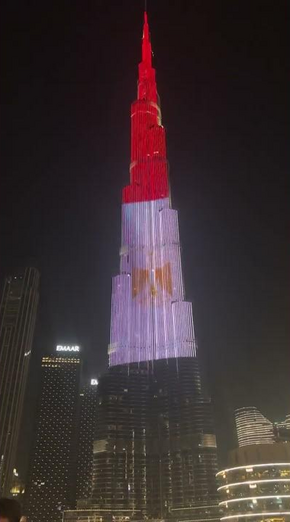
Mina al-Majid has 25 districts, some ranging from industrial to retail in exclusive useage. Many of the distrits in Mina al-Majid find their boundaries defined by main roads or thoroughfares, reflecting their construction and development as phases in comparison to older districts. The oldest and most developed district in the city is the Core, the home of the Burj al-Insijam. The Core, also known as the "First City" (Al-Madinat al-Awwal), was the site of the original fishing village, Beit Massoud and would form the core of the city under Soravian and Etrurian rule. Other notable districts include Saham, located east of the Core by Mina al-Majid Port, it is known to be the poorest district in the city, but also home to one of the oldest spice souqs in Zorasan.
The Core
Central Mina al-Majid is known as 'the Core' (al-Niwāh), also known as the "First City" (Al-Madinat al-Awwal) is the oldest recorded district of the city, being the site of the Beit Massoud, founded in the 14th century. The district also includes the original port of Mina al-Majid, now the principal ro-ro and cruise terminus. Historically, the district was attached to the Zorasani mainland, albiet lined to the its west by the naturally formed saltwater tidal creek, that was later expanded and deepened by Etrurian colonial authorities in the late 19th century, to form a moat, which they named the Grand Canal (Canale Grande) in honour of the grand canal in Povelia. Upon this man-made island, the Etrurians would invest into developing a modern and vibrant base of operations in both trade and its colonial expansion into the then-Gorsanid Empire. Throughout much of its history the "First City" was a densely populated island, with warren-like streets dividing large tenement building, warehouses, offices and administrative buildings. This would remain the case throughout the 20th century and into the early years of the 21st.
When Mina al-Majid was declared part of the New Generation Cities project and declared a special economic zone, much of the city's development focused on the New Souq District, where the first office blocks were built to accomodate the emerging financial services sector. Beginning in 2005, attention turned to Al-Madinat al-Awwal, where citizens were evicted and the warren-like buildings demolished to make way for the modern mixed-use district that exists today. The re-development of the Core displaced approximately 25,000 people and would cost close to €25 billion, much of which provided by the Zorasani central government. Today, the Core district is centred around the Harmony Park (Hadiqat al-Insijam), which contains the Burj al-Insijam, the world's tallest skyscraper, Harmony Fountain and Ittehad Mall, the largest in Zorasan and the world by total area. Within the mall is the Oceanic Wonder, the country's largest aquarium, the Mina al-Majid Arduous Revolution Museum, and the Mina al-Majid Museum of Irfanic History.
The Burj al-Insijam (Harmony Tower), the tallest structure in the world is mixed-use, with the entire city and municipal government operating out of the lower levels, while the federal government also inhabits several floors. The remaining floors are dedicated to commerical office space, high-end hotels and apartments. The project cost €1.6 billion and took six years to complete, the tower is now the central hub for New Year's Eve celebrations, as well as Unification Day, the national holiday.
Other major developments including Pinnacle Tower and Aeon Tower are dedicated to providing luxury residences as well as office space.
As of 2022, the Core had a population of 110,530.
New Souq District
The New Souq District, also known as Madinat Khorasan is a mixed use area immediately southwest of the Burj al-Salam hotel and is the largest of its type in the city, sprawling around 40 hectares. It is centred around the Madinat Khorasan Souk, one of the largest in the city and hosting over 800 stores, bars and restaurants across three levels. Though completed in 2014, the Souk is designed entirely in the traditional Rahelian style, with this design being implemented across the entire district, leaving it built in the style of a traditional Rahelian town, albeit with Pardarian influences. The Souk is fully air-conditioned and provides access to all areas of the district, one of its wings, the "World Avenue" is dedicated to the hosting of foreign high-end brands.
The remaining areas of the district are owned and operated by the Imperial Life Group, a hotel chain notably majority-owned by the Great Soldier Foundation, the holding company of the Zorasani Armed Forces' business interests. These include three boutique hotels, and large summer villas, providing over 1,100 rooms for tourists and short-term residents. The district also provides homes for permanent residents, along the western canal.
Diretly to its northeast, is the Burj al-Salam, the world's tallest hotel and one of the city's most iconic landmarks. It offers 202 rooms and is widely regarded as one of the most exclusive hotels in the world, it too is owned by the Imperial Life Group.
SeaWalk
The SeaWalk district, also known as Western Beach (الشاطئ الغربي; al-Shāṭi al-Ḡarbiyy) is located west of the Core and immediately southwest of the Palm Oceanic archipelago. Originally a hub for fishermen and pearl collectors, it was dramatically redeveloped in the late 2000s and early 2010s, becoming an artificial canal-centric urban area. The SeaWalk district is popular with residents and tourists alike, consisting of numerous high-end stores, art galleries, restaurants, bars, dance clubs and music venues. The SeaWalk also includes the Mina al-Majid VR Planetarium, Municipal History Museum and numerous hotels. The SeaWalk is also home to several financial services, including the Zorasan-branch of Hargreaves, the commodity focused branch of Werania's Armasberg Bank and numerous smaller foreign exchange trading companies indigneous to Zorasan.
The SeaWalks promenades also serve as a marina for privately owned yachts and other vessels.
Palm Oceanic
The Palm Oceanic is another of Mina al-Majid's most iconic sights and its largest mega project to date. Designing of the project began in the late 1990s, as a means of expanding the city's area, owing to constraints along the southern municipal boundary due to terrain. Construction began in 2001 as a joint venture between the Union Corps of Army Engineers, the Estmerish specialist company Aquavant and saw the reclamation of 5.72 km² (2.2 sq mi) from the sea. Constructed in the shame of a palm tree, bound by a crescent, the project provides space for luxury properties, retail and tourism. The project and subsequent land was developed and owned by the Pishtaz Group, a Bandar-e Sattari-based property developer, partly owned by the Great Soldier Foundation.
The central trunk of the Palm, which connects it to the mainland is comprised of retail, high rise apartments and hotels, while the fifteen fronds that branch off are wholly residential. The villas that sit upon the fronds, developed and sold by Pishtaz, were fully sold-off as of 2019, albeit and to much controversy to members of the Zorasani government, military and National Renovation Front elite. Efforts by ordinary citizens and foreigners to purchase property on the Palm were outright rejected from 2009 to 2019, leaving the residential properties exclusively owned by regime elites. Further controversy emerged when it was revealed that housing density was vastly increased to provide further plots and many of the listings were posted on internal government intranet systems. Each frond is sealed off from the trunk by a electronic gate and Security Forces checkpoints, access to the Fronds is only possible through ID cards and electronic tags.
While the fronds were closed off to the general public, the crescent which runs across the top half of the Palm is reserved for tourism and publicly listed residential units and doubles as a breakwater to protect the fronds. The Crescent as of 2023, is home to large five-star hotel resorts, villas and complexes. One of the largest is the Poseidon Gate Hotel, which sits directly atop the Palm and operates the second largest aquarium in the city. The Poseidon Gate hotel is also the first Zorasani resort to operate underwater rooms, as well as rooms lining the hotel's aquarium.
The Palm is serviced by the Ocean Line of the Mina al-Majid Metro - the monorail service runs from the New Souk Interchange, enabling transfers to the Unity Line and operates four stops along the trunk. The Palm also operates a heliport, located on the western side of the crescent, with direct flights to both Mina al-Majid International Airport and Khalid Sadr Regional Airport.
The Palm is also home to the Mina al-Majid Marine Rehabilitation Centre, which treats and rehabilitates sea turtles, dugongs and dolphins. The entire Palm is also a Marine Conservation Zone, with strict bans on fishing and rubbish dumping.
As of 2022, the Palm Oceanic has a permanent population of 12,000.
Ittihad Avenue
Ittihad Avenue (W5 Highway) is the main artery road of the city, that runs parallel to the entire Riyadhi Peninsula coastline, connecting Mina al-Majid with Ghallilah to the east, At-Turbah to the south and smaller industrial towns. The ten-lane highway also bisects the district of the same name, which serves as the city's central business district. Mostly comprised of skyscrapers, it is the economic heart of the city, boasting over 1,000 resident companies, including the Zorasan-branch of numerous multinational companies, conglomerates and major domestic companies. The entire district is a free trade zone, supporting positive environments for commodity trading, foreign exchange, insurance, commerical, retail and investment banking. The district also includes the Mina al-Majid Stock Exchange, the second largest in Zorasan after the Zahedan Stock Exchange, though the MAMSE is built to facilitate international trading on select Zorasani private companies, compared to the listing of state owned enterprises in the ZSE.
The district includes overseas branches of many major international companies, including City Bank, Hargreaves, Morwall International (MIB), CreditReppublica, Armasberg Bank, Rentenbank, HNG Group, Shenkong Investment Bank, Shangean Bank of Commerce, Zhongdong Industrial Bank and the Senria Post Bank.
The district includes landmarks such as the Mina al-Majid World Trade Centre, Prosperity Towers, Trade Towers and the Mina al-Majid Gold Souk.
WaterGardens
The WaterGardens district is an artificial lake and canal city, comprised of spacious villas built in varying international styles. Located south of the New Souk District, it is home to over 35,000 people and is one of the most diverse in ethnicity and religion, being a popular locale for foreign expatriates. The Water Gardens also include numerous international schools including the Mina al-Majid Soravian School, the Senrian School and the Etrurian School, which provide lessons for elementary and secondary level students.
The Water Gardens also include a five-star golf course, a bird sanctuary and numerous retail outlets.
Al-Dawlat
Al-Dawlat (lit. State District) is one of the largest districts by area and the former home of city and municipal authorities, prior to their move into the Burj Insijam. Today, Al-Dawlat is home to various free trade zones and business parks, including the Mina al-Majid Media Zone and the digital services. The district includes the headquarters of the state-owned UCTV, Union Broadcasting Service and Artesh News Service, but also the Zorasan-based studios for EBS, EucloNews, HNO, Shangean Broadcasting Network, SHK, ARE and Zortelekom.
The district's digital free trade zone is home to numerous Zorasani and international companies and start ups including ZistSanduq, the taxi-app Kareem, the e-commerce companies E-Bazaar, DigiTejârat and eJahan, and the world's largest e-commerce company Wangben. The district is also the base for the Union Office for Business and Industrial Support and Zorasani Central Business School. Foreign companies present include the branch offices of PinPin and PinPin Douga, Eiol, Lantu and others.
CanalSide
CanalSide is the newest development currently under construction in Mina al-Majid and is intended to serve as an expansion of the Core, and second financial district. It is currently home to the headquarters of many Zorasani companies operating within the city and nationally, including, Pishtaz Group, Zorasani State Development Bank, the Union Development Sovereign Fund, the Great Soldier Foundation, Zorasani Popular Bank, Union State Credit Bank, Union State Industrial and Agricultural Bank, Union Export Finance Bank and the Union State People's Bank. Also present are the Irfanic finance houses, including the Irfani Universal Bank, Irfanic Development Bank and the Zorasani-branch of the Bank for United Development. The CanalSide district was established as a free trade zone in 2019, and is also designated as a tax free zone.
Southern Side
The Southern Side (al-Jānib al-Janūbiyy) refers to several districts located directly southwest of the Core across the Grand Canal. The Southern Side includes the districts of Al-Rashidyya, Makhmur and Qamar al-Shams. The area is predominately dominated by low-level and low-density housing that houses local Mina-Majidites. The Southern Side is served by the Unity Line of the Mina al-Majid Metro and bus lines that connect the area to the Core. The Southern Side collectively is home to 550,000 people.
Eastern End
The Eastern End (al-Šarqiyy al-Nihāya) is the most populous Section of Mina al-Majid, being home to over 1.5 million people. It is the largest Section of the city and is renowned for its low-rent and often poverty stricken households, where most of the city and municipality's poorest paid workers reside. Much of the Section's urban sprawl was built during late 1980s and early 1990s to house the thousands of construction workers employed to facilitate the redevelopment of the city under the New Generation Cities project. Today, it is home to construction workers, hotel and restaurant workers, city employees and manual labourers.
Western End
The Western End (Al-Jānib al-Ḡarbiyy) refers to several districts west of the SeaWalk and Water Gardens districts that includes the Bawwabat al-Qamar Port. The Western End is near-exclusively industrial and contains several hundred manufacturers, the largest seawater desalination plant and natural gas powerplant. The Western End, which exports via the BQP, includes textile mills, several factories belong to Kushandar, one of the world's largest producer of home appliances and engineer firms.
Government
Mina al-Majid is a Union Municipality, meaning its authorities possess similar powers and autonomy to that of a Union Republic, though retaining control over typical city-governance. As a Union Municipality, its system of government is also identical to that of the Union Republics, which in turn mirror the one-party state nationally. The Municipal government is comprised of five distinct bodies, the Municipal Central Committee - the executive branch, the Municipal Assembly- the legislative branch, the City Administration - focusing on city services and urban management and the Municipal Judicial Authority.
The Union Governor is the head of the executive branch of the Municipality and concurrently serves as the First Secretary of the Municipality's branch of the National Renovation Front and Chairman of the Municipal Central Committee. The Union Governor is elected by the Municipal Assembly (of which he/she must be a sitting member) for a five year term renewable once. As the highest ranking office holder, the Union Governor is tasked with overseeing all departments, agencies and services, including the city administration. The Municipal Central Committee has direct control over the Union Municipality's education, law enforcement, economic policy and healthcare. The Union Governor upon election appoints the City Administrator, who is tasked with overseeing the City Administration, which is dedicated to managing the affairs of Mina al-Majid within its metropolitan boundaries, this ranges from refuse collection, water, gas and electricity utilities and transportation. The City Administrator must be confirmed by vote of the Municipal Assembly before taking office. The incumbent Union Governor and City Administrator are Hussein al-Qasimi and Naim al-Riyadhi respectively, who have served since 2022.
The Municipal Central Committee, mirroring the state-level Union Republic Central Committees and the Central Committee of State nationally, doubles as both the highest-level decision making body for the Municipality and for the region's branch of the National Renovation Front. It is chaired by the Union Governor, with the City Administrator serving as the Deputy Chair and is comprised of the heads of municipal and city level bodies, and heads of internal NRF departments. Half of the Central Committee's members are elected by the Municipal Assembly, with the remaining half appointed by the Union Governor and confirmed by majority vote in the Assembly.
Entirely subordinate to the MCC is the City Administration of Mina al-Majid, this body is wholly focused on the managing of city services and development. Notably, the CA is dependent on funding from the MCC which controls the operating budget for government in the Municipality and has limited power or influence on economic policy, but has full control over urban planning, transportation, refuse collection and utilities.

The Municipal Assembly is the legislative branch of the government, and is comprised of 120 members. These members are drawn from the local-level NRF Districts, who are charged with electing six representatives from their ranks every six-years, with no term limits. This mirrors the national system, in which official members of the National Renovation Front elect representatives, not the general populace through elections, this leaves the NRF in total control over all areas of government within the Municipality. The Municipal Assembly is tasked with overseeing the workings of the city and municipal administrations, debate policy and strategy and can propose legislation to be accepted or rejected by the MCC. The Mina al-Majid Assembly is unique in that its individual committees hold "Open Events", in which members of the public can voice grievances or discuss local matters which can and have effected legislation and policy.
Lastly the Municipal Judicial Authority is the judicial branch of government within the region. The Municipality operates a court-system identical to the federal system, with three distinct circuits. The first, the Union Court System is divided into three, the Popular Court hears civil claims, the Municipal Court hears claims originating from police complaints and the State Court which is the supreme court of the Municipality and hears disputes on law. The second circuit is the Esafkar Court, which is responsible for matters between Irfani and lastly the State Security Tribunal, which is a federal court that deals with matters relating to political crimes and security.
Relationship with Zorasani central government
Owing to the success of the New Generation Cities and Mina al-Majid in particular, the relationship between the Municipal government and federal government has often been tense and prone to bouts of tension. Of all the New Generation Cities, many inside and outside Zorasan classify Mina al-Majid as the most successful, though debate surrounds those most responsible, often divided between the central and municipal governments themselves. The success of Mina al-Majid has also led to numerous cases of its political leaders coming into fierce competition with other powerful figures with the Zorasani one-party state, where governors of Mina al-Majid become locked into power struggles with rivals upon the end of their two-terms, with natural expectation of elevation within national politics.
Other issues surrounding the relationship has been the requirement of Mina al-Majid to retain a more liberal socio-economic atmosphere compared to the rest of the country, for the sake of foreign direct investment and international trade needs. This situation remained low-key during the 1990-2005 period, known as the Saffron Era but became a consistently charged issue following The Turfan (2005-2008), when the Zorasani military and National Renovation Front right-wing factions conspired to restore and fortify ideologically hardline control over government. Under the Fifth (2005-2015) and Sixth (2015-2021) Leadership-Generations in particular, there were repeated clashes over Mina al-Majid's social policies and direction. This culminated in mid-2022 under the current Seventh Leadership-Generation, which orchestrated the removal of then Governor Faris al-Ababbar and City Administrator Abdullah Al Marri and secured the elevation of Al-Qasimi and Al-Riyadhi as their successors. This has served to ease tensions between Mina al-Majid and the Central Government since.
Law enforcement
Law enforcement in Mina al-Majid is conducted by the Union Police Force, which is the national police service and falls under the jurisdiction of the Union Ministry for Internal Affairs. The UPF, which is part of the wider Union Security Forces directorate maintains a Command Headquaters in the Burj al-Insijam alongside the wider USF Headquarters. The Municipal Command of the UPF employs 18,950 police officers, while the USF employs 3,500 armed gendarmes within the Municipality. Mina al-Majid is also one of the most watched cities in the world, with 9.46 CCTV cameras per 1,000 people. It is also the first city in Zorasan to introduce Smart Police Stations, facial recognition systems and widespread use of drones to monitor busy thoroughfares and traffic. The Union Security Forces are known to introduce new innovations and technologies into Mina al-Majid before being deployed to other major cities in Zorasan. Zorasan's wider security apparatus is known to operate within Mina al-Majid, with both the Union Ministry of State Intelligence and Security and the military intelligence service AKHID both operating offices in the Burj al-Insijam. UMSIS and AKHID are also known to operate facilities in other parts of the city, including a shared detention centre near the harbour.
In 2019, Mina al-Majid opened the first police academy to be located outside Zahedan, with the academy providing training for the use of artificial intelligence, drones and digital technology.
In 2021, the first Smart Police Station was opened in the Souq District, these smart stations are self-service centers offering customers to apply digitally for many services, such as criminal, traffic, certification and others, without a traditional visit to the police station. The services are divided four categories. Criminal services enable customers to request victim support, report a bounced cheque or failure to comply with contracts, file a labour complaint, request CCTV footage, file criminal complaints, request home security, report human and drug trafficking and request police information. Traffic Services allow customers to reissue traffic accident reports, apply for a driving licence, applying for a change of vehicle colour and personalised licence plate and to pay fines. Certificates and Permits, customers can request copies of lost certificates, good conduct reports, night work permits, protest requests, road closure permits, clearance and foreclosure certificates and copies of birth, marriage and death certificates. Community Needs, allows customers to apply for visa extensions, tourist protection services, event security permits, job vacancies within government, addresses for places of worship, homeless shelters and access to the Lost and Found database. As of 2023, a further 18 Smart Police Stations have been opened and will be introduced to Sattarishahr and Zahedan in 2024.
Economy
Science and technology
Tourism and retail
Property and real estate
Transport
Transportation across the Union Municipality is controlled and managed by the Municipal Transportation Authority (MTA), an agency directly subordinate to the City Administration of Mina al-Majid. The MTA was established in 1993, prior to the city's dramatic expansion and transformation and has played a key role in urban planning since. Despite this, in 2020 it was estimated that 2,110,490 cars were owned and used across the Municipality, while only 17% of the population relied on public transport.
Road
Rail
Mina al-Majid is serviced by one single major terminus, located across the Grand Canal within the Al-Bab district, accessible from the Burj al-Insijam Core via three foot bridges and two road bridges. The Mina al-Majid Central Terminus provides services for the Peninsula Line and the Northern Union High-Speed Line. The Peninsula Line connects Mina al-Majid with At-Turbah to the south, while the Northern Union High-Speed Service connects Mina al-Majid with Ghallilah, where passengers can board the Union High-Speed Line which runs parallel to the Zorasani coastline, one of the longest high-speed rail links in operation in the world.
The city is serviced by two freight lines that run from At-Turbah and Ghallilah respectively, these freight stations are located in the western and eastern ends of the city.
Metro rail
The Mina al-Majid Metro consists of fourt lines (Unity Line, Harmony Line, Ocean Line and Central Line), which run through financial, retail and residential areas of the city. The Central Line is the longest, running from Beit Salam district in the far-west of the city to Um Sidira in the far-east of the city limits. The Central Line runs parallel to the sea, providing access across the entire west-to-east axis of the city, and operates 39 stations (10 undeground, 6 at ground level and 23 elevated above street level). The Central Line was the first to be built, being constructed from 2003 to 2012. This was followed by the Unity Line, which runs from Khalid Sadr Regional Airport in the southwest, to the Downtown Interchange Station within the Core, it has 12 stations (2 under ground, 5 at ground level and 5 elevated), built between 2006 and 2010. The Harmony line is the third major line, running from Ramailah in the south-east, to the Mina al-Majid International Airport before terminating at the Interchange Station, it has 23 stations, (4 under ground, 7 at ground level and 12 elevated). The final service is the Ocean Line which runs from the New Souk Area, through to Mina al-Majid Marina and up the 'trunk' of the Palm Oceanic archipelago, it has six stations (2 under ground and 4 elevated).
The Metro has a daily ridership of 896,000 as of 2022, a marked increase from previous years.
The Mina al-Majid Metro is the first in Zorasan to be fully automated and driverless. The Metro System is managed by Dahdar Services, which also operates the Zahedan Metro.
Air
Mina al-Majid is serviced by two airports, Mina al-Majid International Airport and Khalid Sadr Regional Airport. The International Airport (IATA:MXM) is the hub for Oceanic Air and serves as the city of Mina al-Majid and At-Turbah, it is the second busiest airport in Zorasan (after Mahrdad Ali Sattari International Airport) and one of the busiest airports in Coius, by passenger traffic. The airport is also one of the busiest cargo airports in the world, handling 2.29 million tons of cargo in 2019. Oceanic Air is the fastest growing privately owned airline in Zorasan and serves 88 destinations in over 20 countries, across three continents. Khalid Sadr Regional Airport is the second to service Mina al-Majid and At-Turbah, receiving domestic flights from other parts of Zorasan and regional countries in Rahelia and Bahia. The airport also doubles as an airbase for the Zorasani Irfanic Revolutionary Air Force.
Sea and waterways
Mina al-Majid is serviced by two port areas, to the west is the Bawwabat al-Qamar Port, which is one of the largest freight handling facilities in Zorasan. It is also the largest man-made harbour in the world, as well as the second busiest in Zorasan after the Port of Chaboksar (Pardarian Union Republic), though marginally busier than the Port of Khadal. BQP was built to support the export of finished goods produced in both the Riyadhi peninsula and industrial cities found in eastern Khazestan and is supported by at least three rail links. BQP encompasses over one million square metres of container yards. It also contains space for medium- and long-term general cargo storage, including seven Hennish barns with a total of 20 thousand square metres and 12 covered sheds covering with 90.5 square metres, the port also consists of 960 thousand square metres of open storage.
The second port, to the east of the city is the original harbour operated during the city's history under Soravian and Etrurian rule. The Mina al-Majid port, located east of the Grand Canal also operates a number of shipyards and maintenance pens (collectively known as the Mina al-Majid Drydocks) that provide services for the off-shore petrochemical facilities found across the Gulf of Parishar. The Port also operates the command centre for the Zorasani Coast Guard, for the Eastern Gulf Region as well as the Union Maritime Emergency Response Service (UMERS), dedicated to providing emergency services for off-shore facilities. With the modernisation and expansion of Bawwabat al-Qamar in the late 2000s, Mina al-Majid was redesigned to accommodate cruise liners, becoming the main entry point for cruising tourists. Notably, plans drawn up in 2014 to expand the drydocks to facilitate shipbuilding was vetoed by the Zorasani central government.
In 2018, Mina al-Majid Port was further expanded to house elements of the Eastern Squadron of the Zorasani Irfanic Revolutionary Navy. Passing military vessels have since become regular sights along the city's seafront.
The Municipal Transportation Authority also regulates and manages the waterway services provided for the city. This includes the hundreds of traditionalist boasts ferrying passengers along the Grand Canal, be they Dhows or Abras. There are over 60 jetties and "boat stops" along the Grand Canal, they operate alongside the official Marine Bus Service - fully air conditioned water taxis that operate along the Grand Canal as well as the seafront.
Demography
| Historical population | ||
|---|---|---|
| Year | Pop. | ±% |
| 1798 | 3,200 | — |
| 1830 | 12,540 | +291.9% |
| 1865 | 22,112 | +76.3% |
| 1890 | 22,885 | +3.5% |
| 1900 | 24,090 | +5.3% |
| 1910 | 26,700 | +10.8% |
| 1934 | 51,200 | +91.8% |
| 1948 | 53,189 | +3.9% |
| 1958 | 135,577 | +154.9% |
| 1965 | 133,993 | −1.2% |
| 1973 | 122,490 | −8.6% |
| 1983 | 294,884 | +140.7% |
| 1990 | 599,392 | +103.3% |
| 1995 | 1,194,300 | +99.3% |
| 2000 | 1,596,000 | +33.6% |
| 2005 | 2,110,583 | +32.2% |
| 2010 | 2,998,100 | +42.1% |
| 2015 | 3,500,402 | +16.8% |
| 2020 | 3,928,280 | +12.2% |
| 2022 | 4,103,600 | +4.5% |
According to the Zorasani central government's District Citizen Address Recording System, the population of the Union Municipality of Mina al-Majid as of 2022 was 4,103,600, an increase of 175,320 from 2020 - the urban population of the city itself was 3,222,793. As of 2022, Mina al-Majid is the eighth most populous city in the country and the second most populous of the New Generation Cities after Chaboksar. Mina al-Majid however, operates one of the strictest migration systems in the country (see below), which has consistently left the city as the lowest ranked in Zorasan for internal migration for thirty years. Owing to its global profile and role as a hub for foreign business and investment for Zorasan, Mina al-Majid has the largest populations of foreign residents and expatriates in the country, this has left the city with a noticeable and lauded "international and global feel" according to commentators. The city is also the most diverse in Zorasan in religion. Historically, Mina al-Majid ranked relatively low in terms of population, however, post Zorasani Unification and the launch of the New Generation Cities reforms saw the city's population grow exponentially from 1990 to 2020.
Due to the Zorasani central government's ban on ethnic-based censuses, it is difficult for researchers to breakdown the city's population by ethnicity and race, with the exception of the expatriate population. In 2022, it was estimated that 67% of the city's population are Rahelian, drawn predominately from Zorasani Rahelian regions such as Khazestan, Irvadistan, Riyadha and Latifard. 20% are further estimated to be Pardarian, drawn mostly from the Pardarian Union Republic, while 6-7% are from Zorasan's smaller ethnic minorities. The remaining 6-7% are the population are determined to be expatriates, which remain the only group to be officially identified by ethnicity. According to the 2022 DCARS report, 287,252 citizens are foreign expats - Shangeans make up 22% (63,195) of the expat population, followed by Soravians at 18% (51,705), Weranians 10% (28,725), Senrians at 10% (28,723), Estmerish at 8% (22,980), Etrurians at 7% (20,107), Gaullicans at 6% (17,235), Hennish at 5% (14,362), Chistovodians at 5%, Grande Asterian at 3% (8,617), Satucin at 2% (5,745) and small communities.
The median age in the emirate was about 27 years, slightly below the national average of 31. This ranks Mina al-Majid as the second youngest city in the country after Zahedan. In 2018, there were estimated to be 15.54 births and 1.99 deaths per 1,000 people.
Rahelian and Pasdani are the two official languages in Mina al-Majid, however, public information is broadcast in multiple languages, including Soravian, Esmterish, Shangean and Gaullican. Riyadhi Rahelian is the most spoken dialect among Rahelians, while Zahedani Pasdani is the most spoken among Pardarians. Other Zorasani languages such as Kexri and Khorazi are often spoken by inhabitants of the city.
Religion
Under the national constitution, the Articles of Union, Irfan is declared the official state religion of Zorasan and all its "Union Republics, Territories and Municipalities indivisible and sacred." The overwhelming majority of Mazars in Mina al-Majid fall under the jurisdiction of the Custodianship of the Faithful, the official clergy of Irfan and subsequently subsidised by both it and the government. Over 70% of Mazars in Mina al-Majid are linked and funded by the Bonyad Emam Parastar, the largest bonyad in Zorasan. However, under the Articles of Union, all Imams are appointed by the federal government through the Union Ministry for Irfanic Culture, Guidance and Affairs. While the national Articles of Union provides for freedom of religion it is not actively enforced and Zorasan ranks among the lowest for freedom of religion globally, however, much like the other New Generation Cities, freedom of religion is provided for and actively protected by authorities.
Mina al-Majid has the largest Sotirian population in Zorasan, but also boasts Zohist, Badi, Tenkyou and Atudite communities. In the DCARS 2022 Report, over 90% of the city's population identified as Irfani, 2.27% were Sotirian, 0.47% were Tenkyou, 0.52% were Zohist and 0.38% were Badist. Episemliasm was the largest denomination of Sotirianity practiced in 2022, with Solarian Catholicism coming a close second, and Amendism coming third.
Non-Irfanic groups can own their own houses of worship, where they can practice their religion freely, by requesting a land grant and permission to build a compound, this will often come with a government grant to construct the compound. Under Municipal Law, non-Irfanic groups are also permitted to distribute religious literature and advertise their functions to the public. Notably, the Municipal Government in cooperation with the Central Government and Irfanic Authorities actively promotes joint-ventures between Irfanic and Sotirian groups, including charitable events, festivals and educational programmes. The Solarian Catholics are served pastorally by the Apostolic Vicariate of Southern Rahelia. Several Sotirian figures have praised the tolerance experienced in Mina al-Majid, in 2014, Cardinal Carlos Terxiera, the Secretary for the Congregation of Evangelisation remarked that it is "easier and more free to be a Sotirian in Mina al-Majid than some Euclean countries."
Municipal Demographic Control System
One of the most controversial policies of the Union Municipality is the Municipal Demographic Control System, a policy which places severe restrictions upon migration to the city from other parts of Zorasan. Introduced in 1992, the policy is officially enforced to deter and limit the level of internal emigration of Zorasanis from other parts of the country, who may seek to exploit the city's dynamism and economic prosperity, to secure better opportunities and standards of living. This policy during the 1990s and early 2000s was not unique to Mina al-Majid, as Zorasan witnessed considerably high levels of internal migration owing to its economic reforms. However, in 2010, the policy was extended for a further fifty years and tightened, leaving Mina al-Majid as the slowest growing city in terms of population consistently to even 2023. The policy is enforced through roadside checkpoints at its administrative borders, ID checks at its main train terminus and domestic arrivals terminal at the airport.
The Union Municipal government has regularly cited Mina al-Majid's precarious geographical location - the difficulty in sourcing water, limited land for expansion and the nature of its economy - producing less jobs per annum compared to other major Zorasani cities. As such, the policy requires aspiring citizens from elsewhere in the country to meet a number of criteria before being giving a permit of residency. As of 2018 these are: 1) to have a signed employment contract with a Mina al-Majid business or institution, 2) to possess the financial means to purchase a residence within 30 days of signing said contract, 3) to have a Tier 1 Citizenry Grade and 4) Good to Exceptional reference from local National Renovation Front District Committee. The MDCS has enabled the city's authorities to control the number of migrants arriving from other parts of the country, and has enabled the city to maintain full-employment among low-paying sectors, particularly for hotels, restaurants and city services. The Municipal authorities issue out unique ID cards to Mina al-Majid residents that include QR codes that link directly to their residency permits, as well as their formal records held at the Union Ministry for Internal Affairs. People found to be without their ID Cards or lacking an authentic and up-to-date QR code can face being deported to neighbouring Ghallilah, or in the case of foreign nationals, deportation to their country of origin.
To great controversy and criticism, the MDCS does not apply to employees of the Central Government, senior NRF officers or senior members of the Armed Forces and Irfanic clergy in the purchasing of property or permanent residence within the Municipality.
It has been repeatedly remarked that it is easier for foreigners to obtain residency in Mina al-Majid than it is for fellow Zorasanis.
State Lottery
šâns Since 2009, Zorasan has operated a state-organised lottery, which has included numerous financial prizes, a secondary draw ŠânsDaryâ (lit. SeaLuck) sees participants win properties in Mina al-Majid. Since 2009, the ŠânsDaryâ draw has handed out over 3,136 properties. To be eligable for the draw, participants must be 18-years old and a Zorasani citizen. Various property developers in Mina al-Majid have also operated lotteries to help fund developments, by offering up to 10 properties for the prize draw.



